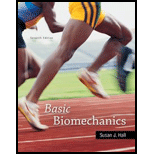
Basic Biomechanics
7th Edition
ISBN: 9780073522760
Author: Susan J Hall
Publisher: McGraw-Hill Education
expand_more
expand_more
format_list_bulleted
Concept explainers
Question
Chapter 4, Problem 8IP
Summary Introduction
To find: The stress present on the surface area of vertebra.
Expert Solution & Answer
Want to see the full answer?
Check out a sample textbook solution
Chapter 4 Solutions
Basic Biomechanics
Ch. 4 - Prob. 1IPCh. 4 - Prob. 2IPCh. 4 - Prob. 3IPCh. 4 - Prob. 4IPCh. 4 - Prob. 5IPCh. 4 - Prob. 6IPCh. 4 - What kinds of fractures are produced only by...Ch. 4 - Prob. 8IPCh. 4 - In Problem 8, how much total stress is present on...Ch. 4 - Why are men less prone than women to vertebral...
Ch. 4 - Hypothesize about the way or ways in which each of...Ch. 4 - Prob. 2APCh. 4 - Prob. 3APCh. 4 - Hypothesize as to the ability of bone to resist...Ch. 4 - How are the bones of birds and fish adapted for...Ch. 4 - Prob. 6APCh. 4 - Hypothesize as to why men are less prone to...Ch. 4 - Prob. 8APCh. 4 - How much compression is exerted on the radius at...Ch. 4 - If the anterior and posterior deltoids both insert...
Knowledge Booster
Learn more about
Need a deep-dive on the concept behind this application? Look no further. Learn more about this topic, bioengineering and related others by exploring similar questions and additional content below.Similar questions
- Your friend runs out of gas and you have to help push his car. Discuss the sequence of bones and joints that convey the forces passing from your hand, through your upper limb and your pectoral girdle, and to your axial skeleton.arrow_forwardThe talus bone of the foot receives the weight of the body from the tibia. The talus bone then distributes this weight toward the ground in two directions: one-half of the body weight is passed in a posterior direction and one-half of the weight is passed in an anterior direction. Describe the arrangement of the tarsal and metatarsal bones that are involved in both the posterior and anterior distribution of body weight.arrow_forwardHow many bones are there in the upper limbs combined? 20 30 40 60arrow_forward
- The pelvis ________. has a subpubic angle that is larger in females consists of the two hip hones, but does not include the sacrum or coccyx has an obturator foramen, an opening that is defined in part by the sacrospinous and sacrotuberous ligaments has a space located inferior to the pelvic brim called the greater pelvisarrow_forwardInflamed and swollen tendons caught in the narrow space between the bones within the shoulder joint cause the condition known as ____________________. impingement syndrome intermittent claudicationarrow_forwardDescribe the two types of cartilaginous joints and give examples of each.arrow_forward
- Discuss the structures that contribute to support of the shoulder joint.arrow_forwardWhich statement is tine concerning the knee joint? The lateral meniscus is an intrinsic ligament located on the lateral side of the knee joint. Hyperextension is resisted by the posterior cruciate ligament. The anterior cruciate ligament supports the knee when it is flexed and weight bearing. The medial meniscus is attached to the tibial collateral ligament.arrow_forwardThe primary curvatures of the vertebral column ________. include the lumbar curve are remnants of the original fetal curvature include the cervical curve develop after the time of birtharrow_forward
- What is the function of the erector spinae? movement of the arms stabilization of the pelvic girdle postural support rotating of the vertebral columnarrow_forwardHow many bones fuse in adulthood to form the hip bone? 2 3 4 5arrow_forwardAt a synovial joint, the synovial membrane ________. forms the fibrous connective walls of the joint cavity is the layer of cartilage that covers the articulating surfaces of the bones forms the intracapsular ligaments secretes the lubricating synovial fluidarrow_forward
arrow_back_ios
SEE MORE QUESTIONS
arrow_forward_ios
Recommended textbooks for you
 Anatomy & PhysiologyBiologyISBN:9781938168130Author:Kelly A. Young, James A. Wise, Peter DeSaix, Dean H. Kruse, Brandon Poe, Eddie Johnson, Jody E. Johnson, Oksana Korol, J. Gordon Betts, Mark WomblePublisher:OpenStax College
Anatomy & PhysiologyBiologyISBN:9781938168130Author:Kelly A. Young, James A. Wise, Peter DeSaix, Dean H. Kruse, Brandon Poe, Eddie Johnson, Jody E. Johnson, Oksana Korol, J. Gordon Betts, Mark WomblePublisher:OpenStax College- Understanding Health Insurance: A Guide to Billin...Health & NutritionISBN:9781337679480Author:GREENPublisher:Cengage
 Medical Terminology for Health Professions, Spira...Health & NutritionISBN:9781305634350Author:Ann Ehrlich, Carol L. Schroeder, Laura Ehrlich, Katrina A. SchroederPublisher:Cengage Learning
Medical Terminology for Health Professions, Spira...Health & NutritionISBN:9781305634350Author:Ann Ehrlich, Carol L. Schroeder, Laura Ehrlich, Katrina A. SchroederPublisher:Cengage Learning

Anatomy & Physiology
Biology
ISBN:9781938168130
Author:Kelly A. Young, James A. Wise, Peter DeSaix, Dean H. Kruse, Brandon Poe, Eddie Johnson, Jody E. Johnson, Oksana Korol, J. Gordon Betts, Mark Womble
Publisher:OpenStax College



Understanding Health Insurance: A Guide to Billin...
Health & Nutrition
ISBN:9781337679480
Author:GREEN
Publisher:Cengage


Medical Terminology for Health Professions, Spira...
Health & Nutrition
ISBN:9781305634350
Author:Ann Ehrlich, Carol L. Schroeder, Laura Ehrlich, Katrina A. Schroeder
Publisher:Cengage Learning